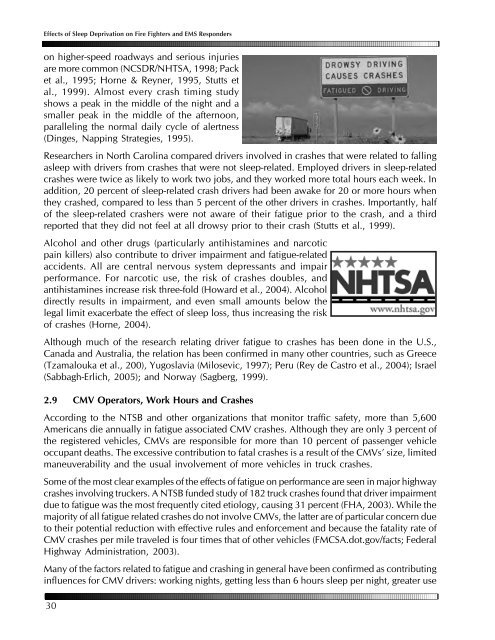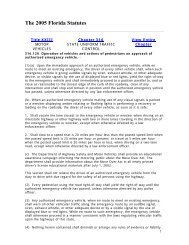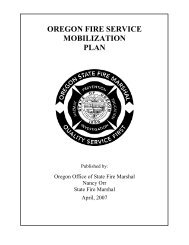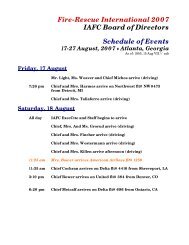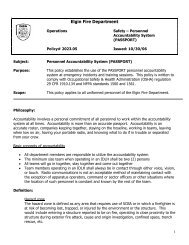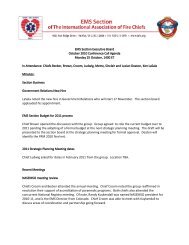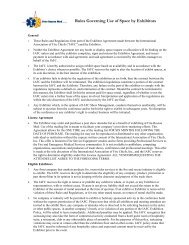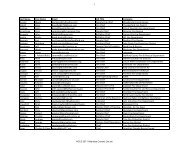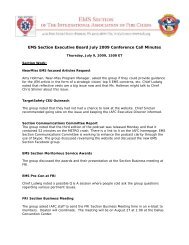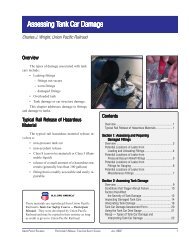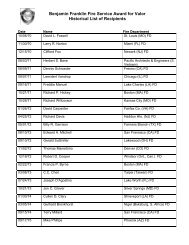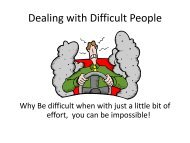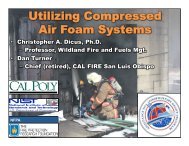Effects of Sleep Deprivation on Fire Fighters and EMS ... - NAEMT
Effects of Sleep Deprivation on Fire Fighters and EMS ... - NAEMT
Effects of Sleep Deprivation on Fire Fighters and EMS ... - NAEMT
You also want an ePaper? Increase the reach of your titles
YUMPU automatically turns print PDFs into web optimized ePapers that Google loves.
<str<strong>on</strong>g>Effects</str<strong>on</strong>g> <str<strong>on</strong>g>of</str<strong>on</strong>g> <str<strong>on</strong>g>Sleep</str<strong>on</strong>g> <str<strong>on</strong>g>Deprivati<strong>on</strong></str<strong>on</strong>g> <strong>on</strong> <strong>Fire</strong> <strong>Fighters</strong> <strong>and</strong> <strong>EMS</strong> Resp<strong>on</strong>ders<br />
<strong>on</strong> higher-speed roadways <strong>and</strong> serious injuries<br />
are more comm<strong>on</strong> (NCSDR/NHTSA, 1998; Pack<br />
et al., 1995; Horne & Reyner, 1995, Stutts et<br />
al., 1999). Almost every crash timing study<br />
shows a peak in the middle <str<strong>on</strong>g>of</str<strong>on</strong>g> the night <strong>and</strong> a<br />
smaller peak in the middle <str<strong>on</strong>g>of</str<strong>on</strong>g> the afterno<strong>on</strong>,<br />
paralleling the normal daily cycle <str<strong>on</strong>g>of</str<strong>on</strong>g> alertness<br />
(Dinges, Napping Strategies, 1995).<br />
Researchers in North Carolina compared drivers involved in crashes that were related to falling<br />
asleep with drivers from crashes that were not sleep-related. Employed drivers in sleep-related<br />
crashes were twice as likely to work two jobs, <strong>and</strong> they worked more total hours each week. In<br />
additi<strong>on</strong>, 20 percent <str<strong>on</strong>g>of</str<strong>on</strong>g> sleep-related crash drivers had been awake for 20 or more hours when<br />
they crashed, compared to less than 5 percent <str<strong>on</strong>g>of</str<strong>on</strong>g> the other drivers in crashes. Importantly, half<br />
<str<strong>on</strong>g>of</str<strong>on</strong>g> the sleep-related crashers were not aware <str<strong>on</strong>g>of</str<strong>on</strong>g> their fatigue prior to the crash, <strong>and</strong> a third<br />
reported that they did not feel at all drowsy prior to their crash (Stutts et al., 1999).<br />
Alcohol <strong>and</strong> other drugs (particularly antihistamines <strong>and</strong> narcotic<br />
pain killers) also c<strong>on</strong>tribute to driver impairment <strong>and</strong> fatigue-related<br />
accidents. All are central nervous system depressants <strong>and</strong> impair<br />
performance. For narcotic use, the risk <str<strong>on</strong>g>of</str<strong>on</strong>g> crashes doubles, <strong>and</strong><br />
antihistamines increase risk three-fold (Howard et al., 2004). Alcohol<br />
directly results in impairment, <strong>and</strong> even small amounts below the<br />
legal limit exacerbate the effect <str<strong>on</strong>g>of</str<strong>on</strong>g> sleep loss, thus increasing the risk<br />
<str<strong>on</strong>g>of</str<strong>on</strong>g> crashes (Horne, 2004).<br />
Although much <str<strong>on</strong>g>of</str<strong>on</strong>g> the research relating driver fatigue to crashes has been d<strong>on</strong>e in the U.S.,<br />
Canada <strong>and</strong> Australia, the relati<strong>on</strong> has been c<strong>on</strong>firmed in many other countries, such as Greece<br />
(Tzamalouka et al., 200), Yugoslavia (Milosevic, 1997); Peru (Rey de Castro et al., 2004); Israel<br />
(Sabbagh-Erlich, 2005); <strong>and</strong> Norway (Sagberg, 1999).<br />
2.9 CMV Operators, Work Hours <strong>and</strong> Crashes<br />
According to the NTSB <strong>and</strong> other organizati<strong>on</strong>s that m<strong>on</strong>itor traffic safety, more than 5,600<br />
Americans die annually in fatigue associated CMV crashes. Although they are <strong>on</strong>ly 3 percent <str<strong>on</strong>g>of</str<strong>on</strong>g><br />
the registered vehicles, CMVs are resp<strong>on</strong>sible for more than 10 percent <str<strong>on</strong>g>of</str<strong>on</strong>g> passenger vehicle<br />
occupant deaths. The excessive c<strong>on</strong>tributi<strong>on</strong> to fatal crashes is a result <str<strong>on</strong>g>of</str<strong>on</strong>g> the CMVs’ size, limited<br />
maneuverability <strong>and</strong> the usual involvement <str<strong>on</strong>g>of</str<strong>on</strong>g> more vehicles in truck crashes.<br />
Some <str<strong>on</strong>g>of</str<strong>on</strong>g> the most clear examples <str<strong>on</strong>g>of</str<strong>on</strong>g> the effects <str<strong>on</strong>g>of</str<strong>on</strong>g> fatigue <strong>on</strong> performance are seen in major highway<br />
crashes involving truckers. A NTSB funded study <str<strong>on</strong>g>of</str<strong>on</strong>g> 182 truck crashes found that driver impairment<br />
due to fatigue was the most frequently cited etiology, causing 31 percent (FHA, 2003). While the<br />
majority <str<strong>on</strong>g>of</str<strong>on</strong>g> all fatigue related crashes do not involve CMVs, the latter are <str<strong>on</strong>g>of</str<strong>on</strong>g> particular c<strong>on</strong>cern due<br />
to their potential reducti<strong>on</strong> with effective rules <strong>and</strong> enforcement <strong>and</strong> because the fatality rate <str<strong>on</strong>g>of</str<strong>on</strong>g><br />
CMV crashes per mile traveled is four times that <str<strong>on</strong>g>of</str<strong>on</strong>g> other vehicles (FMCSA.dot.gov/facts; Federal<br />
Highway Administrati<strong>on</strong>, 2003).<br />
Many <str<strong>on</strong>g>of</str<strong>on</strong>g> the factors related to fatigue <strong>and</strong> crashing in general have been c<strong>on</strong>firmed as c<strong>on</strong>tributing<br />
influences for CMV drivers: working nights, getting less than 6 hours sleep per night, greater use<br />
30


